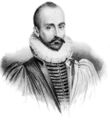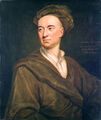Template:Selected anniversaries/February 28: Difference between revisions
No edit summary |
No edit summary |
||
| Line 2: | Line 2: | ||
File:Michel de Montaigne.jpg|link=Michel de Montaigne (nonfiction)|1533: Philosopher and author [[Michel de Montaigne (nonfiction)|Michel de Montaigne]] born. He will be one of the most significant philosophers of the French Renaissance, known for popularizing the essay as a literary genre. | File:Michel de Montaigne.jpg|link=Michel de Montaigne (nonfiction)|1533: Philosopher and author [[Michel de Montaigne (nonfiction)|Michel de Montaigne]] born. He will be one of the most significant philosophers of the French Renaissance, known for popularizing the essay as a literary genre. | ||
||1535: Cornelius Gemma born ... astronomer and astrologer. | ||1535: Cornelius Gemma born ... astronomer and astrologer. Pic. | ||
File:Jost Bürgi.jpg|link=Jost Bürgi (nonfiction)|1552: Clockmaker and mathematician [[Jost Bürgi (nonfiction)|Jost Bürgi]] born. He will be recognized during his own lifetime as one of the most excellent mechanical engineers of his generation. | File:Jost Bürgi.jpg|link=Jost Bürgi (nonfiction)|1552: Clockmaker and mathematician [[Jost Bürgi (nonfiction)|Jost Bürgi]] born. He will be recognized during his own lifetime as one of the most excellent mechanical engineers of his generation. | ||
| Line 18: | Line 18: | ||
||1735: Alexandre-Théophile Vandermonde born ... mathematician, musician and chemist who worked with Bézout and Lavoisier; his name is now principally associated with determinant theory in mathematics. Pic: http://serge.mehl.free.fr/chrono/Vandermonde.html | ||1735: Alexandre-Théophile Vandermonde born ... mathematician, musician and chemist who worked with Bézout and Lavoisier; his name is now principally associated with determinant theory in mathematics. Pic: http://serge.mehl.free.fr/chrono/Vandermonde.html | ||
||1742: Willem Jacob 's Gravesande dies ... mathematician and natural philosopher, chiefly remembered for developing experimental demonstrations of the laws of classical mechanics. As professor of mathematics, astronomy, and philosophy at Leiden University, he helped to propagate Isaac Newton's ideas in Continental Europe. | ||1742: Willem Jacob 's Gravesande dies ... mathematician and natural philosopher, chiefly remembered for developing experimental demonstrations of the laws of classical mechanics. As professor of mathematics, astronomy, and philosophy at Leiden University, he helped to propagate Isaac Newton's ideas in Continental Europe. Pic. | ||
||1743: René Just Haüy born ... priest and mineralogist, commonly styled the Abbé Haüy after he was made an honorary canon of Notre Dame. Due to his innovative work on crystal structure and his four-volume ''Traité de Minéralogie'' (1801), he is often referred to as the "Father of Modern Crystallography". During the French revolution he also helped to establish the metric system. Pic. | ||1743: René Just Haüy born ... priest and mineralogist, commonly styled the Abbé Haüy after he was made an honorary canon of Notre Dame. Due to his innovative work on crystal structure and his four-volume ''Traité de Minéralogie'' (1801), he is often referred to as the "Father of Modern Crystallography". During the French revolution he also helped to establish the metric system. Pic. | ||
Revision as of 07:37, 27 February 2019
1533: Philosopher and author Michel de Montaigne born. He will be one of the most significant philosophers of the French Renaissance, known for popularizing the essay as a literary genre.
1552: Clockmaker and mathematician Jost Bürgi born. He will be recognized during his own lifetime as one of the most excellent mechanical engineers of his generation.
1692: Physician, satirist, and polymath John Arbuthnot uses Gnomon algorithm techniques to rewrite existing manuscripts using satirical premises.
1901: Chemist, biochemist, peace activist, author, and educator Linus Pauling born.
1944: Der Reichsspritzenmeister develops new drug to stimulate crimes against mathematical constants.
2017: Steganographic analysis of excerpt from "Burglars" unexpected reveals "at least half a gigabyte of encrypted data, probably related to the ENIAC program".





